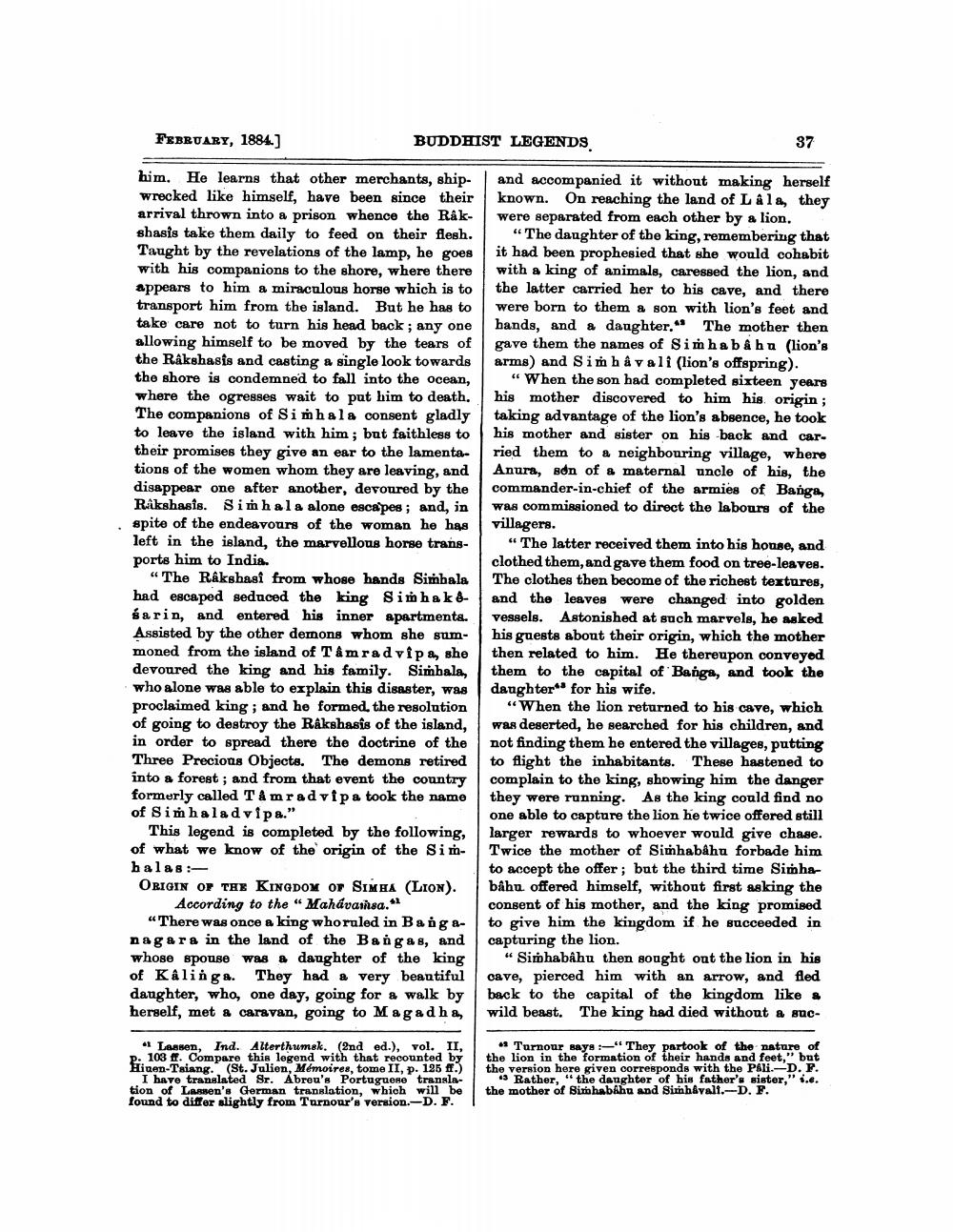________________
FEBRUARY, 1884.)
BUDDHIST LEGENDS
37
him. He learns that other merchants, ship- wrecked like himself, have been since their arrival thrown into a prison whence the Råkshasis take them daily to feed on their flesh. Taught by the revelations of the lamp, he goes with his companions to the shore, where there appears to him a miraculous horse which is to transport him from the island. But he has to take care not to turn his head back; any one allowing himself to be moved by the tears of the Rakshasis and casting a single look towards the shore is condemned to fall into the ocean, where the ogresses wait to put him to death. The companions of Sinhala consent gladly to leave the island with him ; but faithless to their promises they give an ear to the lamentations of the women whom they are leaving, and disappear one after another, devoured by the Rikshasis. Sinhala alone escapes; and, in spite of the endeavours of the woman he has left in the island, the marvellous horse transports him to India.
"The Rakshasi from whose hands Simbala had escaped seduced the king Simhakesa rin, and entered his inner apartmenta. Assisted by the other demons whom she summoned from the island of Tâmradvipa, she devoured the king and his family. Simbala, who alone was able to explain this disaster, was proclaimed king; and he formed the resolution of going to destroy the Rakshasis of the island, in order to spread there the doctrine of the Three Precions Objects. The demons retired into a forest; and from that event the country formerly called Tâmradvipa took the name of Sinhaladvipa."
This legend is completed by the following, of what we know of the origin of the Simhalas :ORIGIN OF THE KINGDOM OF SIMEA (Lion).
According to the "Mahavainsa." “There was once a king whoruled in Bang &nagara in the land of the Bangas, and whose spouse was a daughter of the king of Kalinga. They had a very beautiful danghter, who, one day, going for & walk by herself, met & caravan, going to Magadhe,
and accompanied it without making herself known. On reaching the land of L âle, they were separated from each other by a lion.
"The daughter of the king, remembering that it had been prophesied that she would cohabit with a king of animals, caressed the lion, and the latter carried her to his cave, and there were born to them a son with lion's feet and hands, and a daughter." The mother then gave them the names of Simha baha (lion's arms) and Simh â vali (lion's offspring).
" When the son had completed sixteen years his mother discovered to him his origin; taking advantage of the lion's absence, he took his mother and sister on his back and car. ried them to a neighbouring village, where Anura, son of a maternal uncle of his, the commander-in-chief of the armies of Banga, was commissioned to direct the labours of the villagers.
“The latter received them into his house, and clothed them, and gave them food on tree-leaves. The clothes then become of the richest textures, and the leaves were changed into golden vessels. Astonished at such marvels, he asked his guests about their origin, which the mother then related to him. He thereupon conveyed them to the capital of Banga, and took the daughter' for his wife.
"When the lion returned to his cave, which was deserted, he searched for his children, and not finding them he entered the villages, putting to fight the inhabitants. These hastened to complain to the king, showing him the danger they were running. As the king could find no one able to capture the lion he twice offered still larger rewards to whoever would give chase. Twice the mother of Simhabahu forbade him to acoept the offer ; but the third time Simha bahu offered himself, without first asking the consent of his mother, and the king promised to give him the kingdom if he succeeded in capturing the lion.
"Simhabâhu then sought out the lion in his cave, pierced him with an arrow, and fled back to the capital of the kingdom like wild beast. The king had died without a suc
"Lassen, Ind. Alterthumsk. (2nd ed.), vol. II, P. 103 ff. Compare this legend with that recounted by Hiven-Triang. (St. Julien, Mémoires, tome II, p. 125 ff.)
I have translated Sr. Abreu's Portuguese translation of Lassen's German translation, which will be found to differ slightly from Turnour's version.-D. F.
• Turnour says :-" They partook of the nature of the lion in the formation of their hands and feet," but the version here given oorresponds with the PAR. D.F.
13 Rather," the daughter of his father's sister," i.e. the mother of Bibhabahu and
[email protected]. F.




